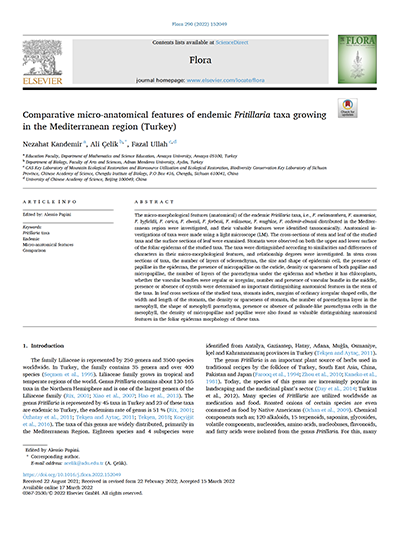NEWS 2022
Comparative micro-anatomical features of endemic Fritillaria taxa growing in the Mediterranean region (Turkey)
Nezahat KANDEMIR1, Ali ÇELIK2, Fazal ULLAH3, 4
Flora 290 (2022) 152049
https://doi.org/10.1016/j.flora.2022.152049
1 Education Faculty, Department of Mathematics and Science Education, Amasya University, Amasya 05100, Turkey
2 Department of Biology, Faculty of Arts and Sciences, Adnan Menderes University, Aydın, Turkey
3 CAS Key Laboratory of Mountain Ecological Restoration and Bioresource Utilization and Ecological Restoration, Biodiversity Conservation Key Laboratory of Sichuan Province, Chinese Academy of Science, Chengdu Institute of Biology, P.O Box 416, Chengdu, Sichuan 610041, China
4 University of Chinese Academy of Science, Beijing 100049, China
Abstract
The micro-morphological features (anatomical) of the endemic Fritillaria taxa, i.e., F. melananthera, F. asumaniae, F. byfieldii, F. carica, F. elwesii, F. forbesii, F. milasense, F. mughlae, F. ozdemir-elmasii distributed in the Mediter-ranean region were investigated, and their valuable features were identified taxonomically. Anatomical in-vestigations of taxa were made using a light microscope (LM). The cross-sections of stem and leaf of the studied taxa and the surface sections of leaf were examined. Stomata were observed on both the upper and lower surface of the foliar epiderma of the studied taxa. The taxa were distinguished according to similarities and differences of characters in their micro-morphological features, and relationship degrees were investigated. In stem cross sections of taxa, the number of layers of sclerenchyma, the size and shape of epidermis cell, the presence of papillae in the epiderma, the presence of micropapillae on the cuticle, density or sparseness of both papillae and micropapillae, the number of layers of the parenchyma under the epiderma and whether it has chloroplasts, whether the vascular bundles were regular or irregular, number and presence of vascular bundle in the middle, presence or absence of crystals were determined as important distinguishing anatomical features in the stem of the taxa. In leaf cross sections of the studied taxa, stomata index, margins of ordinary irregular shaped cells, the width and length of the stomata, the density or sparseness of stomata, the number of parenchyma layer in the mesophyll, the shape of mesophyll parenchyma, presence or absence of palisade-like parenchyma cells in the mesophyll, the density of micropapillae and papillae were also found as valuable distinguishing anatomical features in the foliar epiderma morphology of these taxa.




